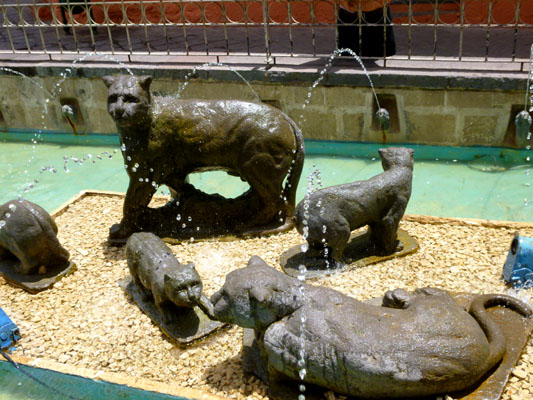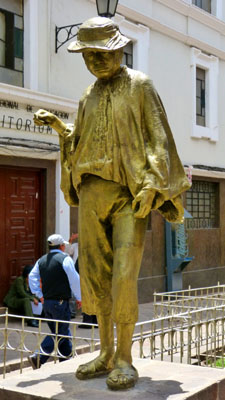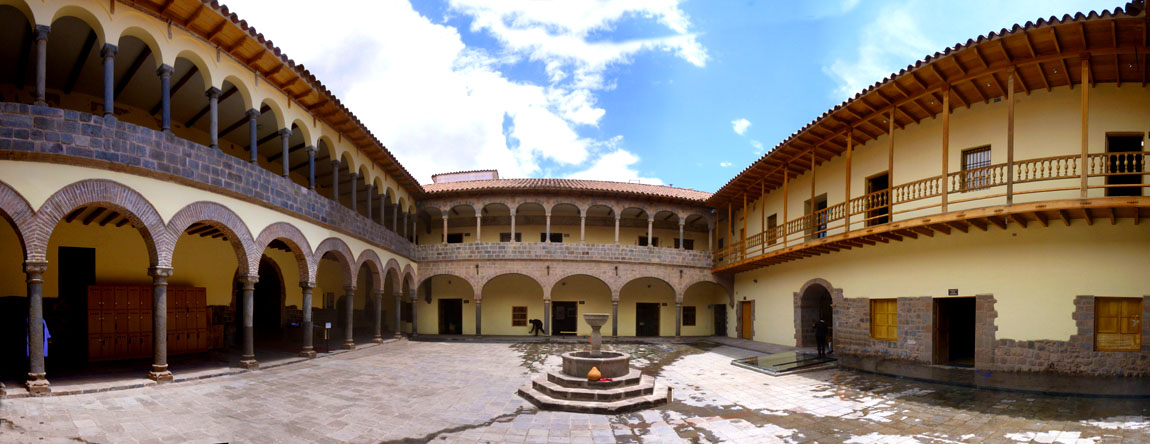

 |
November 17, 2014: Our First Day in Cuzco |
 |
Return to the Index for Our Stay in Cuzco |
Today, we have our full day here in Cuzco. Greg had not felt like walking around two days ago, but today I think he will. Also on this page, I'll give you a tour of our apartment here in Cuzco.
Walking Around Cuzco
Before we left the apartment, I went to the front window and took a series of photographs so I could put them together into a panoramic view from the front of our apartment. That view is below:
 The View from the Front Window of Our Apartment |
Then we left the apartment and followed the familiar route through our neighborhood up to Avenue Agustin Gamarra.
|
To view the slideshow, just click on the image at left and I will open the slideshow in a new window. In the slideshow, you can use the little arrows in the lower corners of each image to move from one to the next, and the index numbers in the upper left of each image will tell you where you are in the series. When you are finished looking at the pictures, just close the popup window.
When we got to the top of Professional Street, we took the stairs up to the avenue, and then continued our walk by going northeast around the curve of the avenue. Along the way, we passed a couple of Peruvian women in traditional dress carrying some possessions along the street. We also passed one of the innumerable little hole-in-the-wall stores and eating places that are so prevalent around Cuzco. This store seemed to have just about everything, as the sign out front seems to indicate. We crossed Avenue San Martin and then turned north on Avenue del Sol towards Plaza Pumaqchupan.
Plaza Pumaqchupan
|
Here are clickable thumbnails for some of the pictures we took here at Plaza Pumaqchupan:

|
During the Inca period in Cusco, Paqchas (water sources) abounded. The original sources no longer exist, but this one was rebuilt on the supposed site of a much earlier one. Near the fountain is the monument to the Incan emperor Pachacutec. Pachacutec was the ninth Sapa Inca (1438–1471) of the Kingdom of Cusco, and his name means "he who shakes the earth". During his reign, Cusco grew from a hamlet into an empire; he began an era of conquest that, within three generations, expanded the Inca dominion from the valley of Cusco to nearly the whole of western South America. Most archaeologists now believe that the famous Inca site of Machu Picchu was built as an estate for him.
Qurikancha
|
Qurikancha (the spellings vary, but the name is constructed from "quri" or "gold" and "kancha" which is an "enclosure" or "enclosed place") was originally called "Quechua" or "sun house" and was the most important temple in the Inca Empire, dedicated primarily to Inti, the Sun God. It was one of the most revered temples of the capital city of Cusco.
|
The walls were once covered in sheets of solid gold, and its adjacent courtyard was filled with golden statues. Spanish reports tell of its opulence that was "fabulous beyond belief". When the Spanish required the Inca to raise a ransom in gold for the life of the leader Atahualpa, most of the gold was collected from Qurikancha.
There is a broad lawn below the walls, and beneath the surface there is an archaeological museum, which contains numerous interesting pieces, including mummies, textiles, and sacred idols from the site. The site now also includes the Church and Convent of Santo Domingo. We did not visit the museum, but just took some pictures of the site of temple and of the convent beyond. You can click on the thumbnails below to have a look at some of these:

|
From Avenue El Sol, we repeated our route from two days ago and walked up the street in front of the convent and then through some of the streets north of it, working our way up to Plaza de Armas.
|
We took a few candid shots as we walked along- just typical Cuzcoan street scenes. Use the thumbnails below to have a look at some of these pictures:

|
Just before we reached the major street about a block south of Plaza de Armas, we found a little "pocket park" which had some shade trees, a few benches, some sculptures and a fountain. There are some pictures from this little park below:
 |
 |
 |
Casa Concha Museum/Museo de Machu Picchu
|
There are 360 items from Machu Picchu that were returned to Peru by Yale University; these have special meaning for the Incas and are also of much interest to the many tourists who visit. The museum spans both levels of the old home. On the second level there are also artifacts more recent than those from Machu Picchu; there are ceramic, lithic, and metal items from the excavations here in the middle of the twentieth century as well as numerous bones that were found nearby.
Wandering through the museum was immensely interesting, and we spent more than an hour here. It was a shame that we could not take pictures inside the galleries, for there were a number of interesting items on display.
|
|
We also took numerous pictures in the courtyard, and there are clickable thumbnails below for three of the best of these:
 |
The last picture from Casa Concha was a panorama of the courtyard that I made by taking five separate pictures and stitching them together. I think the perspective is interesting:
 The Courtyard of Casa Concha- the Museo de Machu Picchu |
Lunch
|
We went in and up the stairs to find a little restaurant that might have been a little hippie restaurant from the Summer of Love or, more recently, something like the Cosmic Cafe here in Dallas. It was vegetarian, naturally, with little tables, a small buffet and an upstairs area where we found a table for ourselves. The charity turned out to be for little kids, run by a couple of Americans and a group of Peruvians; there were places for contributions as well as little crafts for sale.
The food was actually quite good, and certainly reasonable enough. There were some spicy sauces that we all enjoyed and we certainly got plenty to eat. While the other three were downstairs getting their food, I took a picture of the buffet and downstairs area from our perch on the upstairs balcony; you can see that picture here.
Fred took a couple of pictures as we were actually having lunch, and you can use the clickable thumbnails below to have a look at them:
 |
It was a nice lunch and just what we needed. When we were done, we left the restaurant to return to Plaza d'Armas. On our way, we passed a little bookshop and Greg wanted to go in to have a look. We all did, and up behind one of the counters, Fred found a colorful mural.
Plaza de Armas
|
Pretty much in the center of the plaza there is a very pretty fountain with a statue called "The Inca" on top of it. The original statue, brought to Cuzco by an archaeologist from New York, was of a North American Indian, complete with bow and arrow. This statue was eventually replaced with the one that is there at present, although some believe that The Inca slights the obvious impact of the Spanish colonial era.
The Plaza de Armas has always been the heart of Cusco, from the time of the Inca Empire when the square was called Huacaypata or Aucaypata, to modern day. The center of the square is a nice place to rest on the benches, soak up the gardens, and admire the fountain in the center. The area is also very lively and beautiful at night, with people mulling about and the architecture lit up with spotlights. Below are clickable thumbnails for some of the pictures we took in and around the plaza:
 |
We walked all around the plaza this afternoon, looking at the churches and other structures surrounding it. The Cathedral, on the northeast side of the Plaza de Armas is the main attraction, where locals and tourists often spend time lounging on the stairs in front. On one side of the Cathedral is the church of Jesus Maria and on the other is El Triounfo.
|
The Cusco Cathedral houses an impressive collection of art work, with over 400 paintings from the Escuela Cusquena. These paintings from the 16th and 17th century are unique in that they are European style with an obvious Andean Indian influence. This can be seen for example, in The Last Supper by Marcos Zapata, which shows the apostles dining on guinea pig. Also of note in the Cathedral are the half-ton main altar made from silver, the cedar choir stalls, and other wood carvings.
The Capilla del Triunfo houses the famous Alonso Cortes de Monroy painting of the 1650 earthquake that devastated Cusco, and it is decorated on top with religious figures.
The southeastern side of the main square is dominated by the church of La Compania, which is easily mistaken for the Cathedral on first glance due to its ornate façade. However, it is obviously smaller and lacking the grand stairs in front. The other two sides of the Plaza de Armas are lined with colonial arcades.
This church, whose construction was initiated by the Jesuits in 1576 on the foundations of the Amarucancha or the palace of the Inca ruler Wayna Qhapaq, is considered one of the best examples of colonial baroque style in the Americas. Its façade is carved in stone and its main altar is made of carved wood covered with gold leaf. It was built over an underground chapel and has a valuable collection of colonial paintings of the Cusco School. We enjoyed just sitting on the steps of La Compañía and watching the activity in the plaza.
|
I made two panoramic views of the Plaza de Armas this afternoon. The first was taken from the corner of the plaza where we first entered, and in it you can see the plaza itself and the Cathedral. That panorama is below:
 |
The other panorama was taken from the steps at the corner of the Cathedral, and in it you can see La Compañía at the left and the plaza and Cathedral as well:
 |
After walking around for a while, we found a little cafe upstairs near El Triounfo, and we went up there to have some lemonade (it was from our table in the cafe that a couple of the pictures above were taken. Towards the end of the afternoon, we headed out of the plaza on our way back home. We returned to the condo to relax for a while before dinner.
A Tour of Our Cuzco Apartment
|
|
|
Before we continue with our tour of the apartment, this would be a good place to put some of the photos that Fred took around the living and dining room and also out the huge picture window at the front of the apartment. Click on the thumbnails below to have a look:
 |
The apartment was long and thin with the living/dining room in front, the kitchen and maid's quarters next towards the back, two bedrooms along the hall and another bedroom at the end.
|
|
I also have some still pictures that I took along the way. I have put some links below so you can have a look at them:
The apartment had another really neat feature, though- a rooftop deck.
|
|
I made a still picture of the rooftop patio, and Fred, up here a bit earlier, took a couple of pictures of the views north from the patio. You can use the thumbnails below to have a look at his pictures:
 |
We'll finish the tour of our apartment with a few other pictures I took this afternoon. One of them was a view looking down the stairs from the rooftop patio, and you can have a look at that picture here. And, finally, when I returned to the front of the apartment I took two more- one of Fred in the dining room and another of Greg in the living room.
That's it for our tour; hope you enjoyed it. We still had some time before dinner, and since we needed a few bananas, I thought I would take a short walk to the market that we had seen nearby on our ride out to the train station yesterday.
An Evening Walk to the Market
|

|
One thing I would like to point out is the difference between the houses and buildings in the area where we were staying and those outside that area to the south and west. You'll notice how small and cramped it seems that the buildings outside our area were. Our area was not much different from much of the in-city living around Dallas, but outside our neighborhood it was much more cramped.
|
The market was a smaller version of some of those that we'd seen on other trips of ours- both in Europe and elsewhere in Central and South America. The market consists of a number of very small vendor stalls underneath a single roof. I assume that, as in other markets, there are also some places where people can eat prepared food as well, but when I got there, it was late ehough in the day that most of the stalls were already closed.
I did find one open stall where they had some bananas for sale, and that's where I took the picture at right. I bought a few bananas from that stall, and also, as I was walking along the street outside, I stopped to buy the last two bananas one woman sitting by the curb had for sale. (We didn't really need them, but it looked like she could use the business; I gave her about twice what I'd given the vendor inside the market, she looked so forlorn.)
There are clickable thumbnails below for some of the pictures I took in and around the market:
 |
When I got back to the apartment, everyone was just about ready to head out to dinner. We'd found a little restaurant online, and so we walked back the way we'd gone early today, stopping at the restaurant a few blocks this side of Plaza de Armas. It was quite good, and everyone enjoyed it.
This was our last day in Cuzco; tomorrow, we'll fly to Lima to spend a couple of days there.
You can use the links below to continue to another photo album page.
 |
November 17, 2014: Our First Day in Cuzco |
 |
Return to the Index for Our Stay in Cuzco |